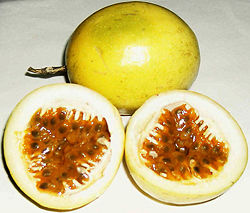Passiflora edulis
| Passion fruit | ||||||||||||||
|---|---|---|---|---|---|---|---|---|---|---|---|---|---|---|
 Ripe yellow passion fruit, or "maracuyá"
|
||||||||||||||
| Scientific classification | ||||||||||||||
|
||||||||||||||
| Binomial name | ||||||||||||||
| Passiflora edulis Sims |
- For the German pop group, see Passion Fruit (band).
Passiflora edulis or passion fruit is a plant cultivated commercially in frost-free areas for its fruit. It is native to South America and widely grown in India, New Zealand, the Caribbean, Brazil, Ecuador, California, southern Florida, Hawaii, Australia, East Africa, Israel and South Africa. The passion fruit is round to oval, yellow or dark purple at maturity, with a soft to firm, juicy interior filled with numerous seeds. The fruit can be grown to eat or for its juice, which is often added to other fruit juices to enhance aroma.
The two types of passion fruit have greatly different exterior appearances. The bright yellow variety of passion fruit, which is also known as the Golden Passionfruit, can grow up to the size of a grapefruit, has a smooth, glossy, light and airy rind, and has been used as a rootstock for the purple passion fruit in Australia.[1] The dark purple passion fruit (for example, in Kenya) is smaller than a lemon, with a dry, wrinkled rind at maturity.
The purple varieties of the fruit reportedly have traces of cyanogenic glycosides in the skin, and hence are mildly poisonous. However, the thick, hard skin is hardly edible, and if boiled (to make jam), the cyanide molecules are destroyed at high temperatures.
These forms of Passiflora edulis have been found to be different species. They occur in different climate regions in nature and bloom at different times of day. The purple fruited species is self fertile and the yellow fruited species, despite claims to the contrary, is self sterile. It requires two clones for pollenization.
Contents |
Uses

- In Australia, it is available commercially fresh and canned. In addition to being added to fruit salads, passion fruit is commonly used in desserts, such as the topping for the pavlova (a meringue cake), cheesecake, and vanilla slice. It is also used to flavor cordials, and an artificially-flavored "passionfruit" soft drink called Passiona is available.
- In the Dominican Republic, it is used to make juice, jams, the chinola flavoured syrup is used on shaved ice and it is also eaten raw sprinkled with sugar.
- In Puerto Rico, where its called Parcha, it is widely believed to lower blood pressure. This is probably because it contains harmala alkaloids and is a mild RIMA.
- In Brazil, passion fruit mousse is a common dessert, and passion fruit seeds are routinely used to decorate the tops of certain cakes. Passion fruit juice is also very common.
- In Indonesia it is eaten straight as a fruit. Nevertheless, it is common to strain the passionfruit for its juice and cook it with sugar to make some sort of thick syrup. It is then mixed with water and ice to be drunk.
- In Hawaii, where it is called lilikoi, it is normally eaten raw. Hawaiians usually crack the rind of the lilikoi either with their hands or teeth and suck out the flavorful pulp and seeds. Lilikoi can also be cut in half and the pulp can easily be scooped out with a spoon. Lilikoi-flavored syrup is a popular topping for shave ice. Ice cream and mochi are also flavored with lilikoi, as well as many other desserts such as cookies, cakes, and ice cream. Lilikoi is also favored as a jam, jelly, as well as a butter. Lilikoi fruits are not widely available in stores, so most of the fruit eaten comes from backyard gardens or wild groves. They however can be found in farmers markets sprinkled throughout the islands.
- Passion fruit juice or syrup is an essential ingredient of some cocktails, particularly the hurricane and the Peruvian maracuya sour.
- In South Africa, passion fruit is used to flavor yogurt. It is also used to flavour soft drinks such as Schweppes Sparkling Granadilla and numerous cordial drinks.
Nutrition
Fresh passion fruit is known to be high in vitamin A, potassium, and dietary fiber. The yellow variety is used for juice processing, while the purple variety is sold in fresh fruit markets. Passion fruit juice is a good source of ascorbic acid (vitamin C).[2]
Names
Sinhala -Wal Dodam (Literally "creeper orange")
See also
- Giant granadilla
- Sweet granadilla
- Granadilla
Gallery
References
- ↑ Reynhardt, Debbie (8 February 2003). "Gardening with Debbie Reynhardt", Dispatch Online, Dispatch Media (Pty) Ltd. Retrieved on 2006-11-20.
- ↑ "Passionfruit", organicfood.com, WSPA. Retrieved on 2008-08-25.